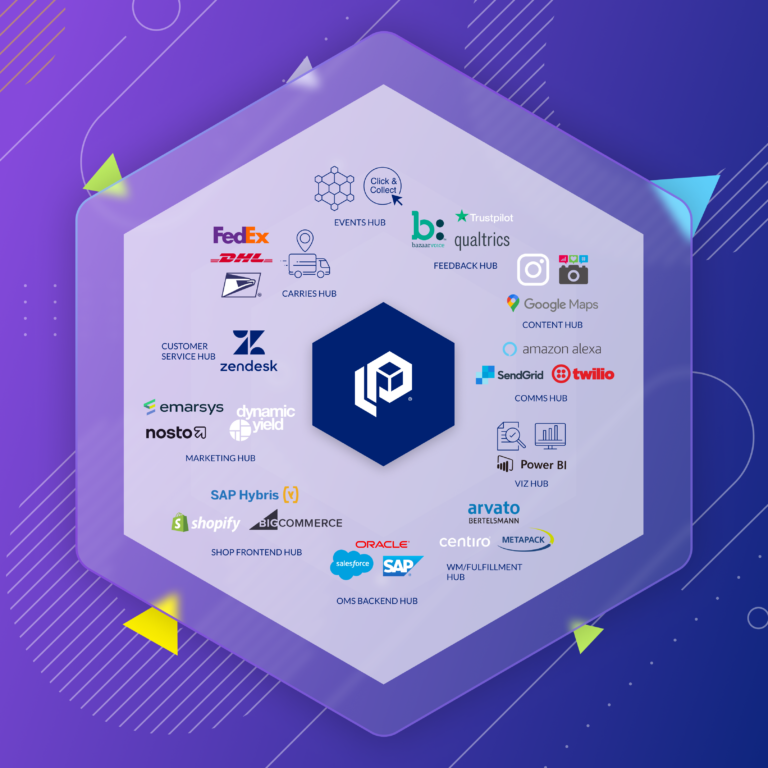What is an ecommerce tech stack and why is it important?
A technology stack for ecommerce websites is essentially the collection of platforms, applications, tools, frameworks, and technologies that ecommerce companies use to manage their business efficiently. These different ecommerce tools and technology are “stacked” on top of one another to create a holistic solution that can help online store owners optimize their day-to-day operations and fuel growth.
With global ecommerce retail sales exceeding $5.7 trillion in 2022 — which comprises 20% of total retail sales — there is immense competition in this industry.
Ecommerce businesses, therefore, need the right technology stack that can help them automate tedious tasks, improve efficiency, and cut costs, thus creating a leaner supply chain while providing an exceptional customer experience. The right retail tech stack will also help online stores manage customer expectations with automated shipping notifications, order tracking, and quick and easy returns management.
Essential features that an ecommerce tech stack should include
| Feature | Description |
|---|---|
| Shopping cart | Lets shoppers store items for purchase |
| Payment gateway | Facilitates credit card and digital payments; must support multiple payment methods and help online stores with PCI compliance |
| Inventory management system | Tracks stock levels in real-time; some solutions can also forecast demand and streamline replenishment |
| Order management system | Tracks orders to streamline fulfillment |
| Customer relationship management | Stores customer information; can help automate and streamline customer relationships and communications |
| Shipping and logistics management | Automates shipping, logistics, and fulfillment processes; optimizes distribution and delivery |
| Post-purchase software | Streamlines the customer journey after they make a purchase through order notifications, tracking pages, returns management, and more |
In the following paragraphs, we’ll explore each of these components in more detail. Have a look:
Shopping cart
When shopping in-store, a customer is likely to walk around while gathering multiple products and placing them onto their cart, before proceeding toward checkout to make a purchase. In contrast, an online shopping cart is a piece of software that mimics this behavior, allowing customers to select and store items in a virtual cart before making a purchase from an online store.
When choosing your ecommerce tech stack, look for a solution that optimizes the user’s checkout experience and keeps your shopping cart abandonment rate to a minimum. It should also have robust security and discounting features and ensure PCI compliance. Popular options in this category include Shift4Shop, X-Cart, OpenCart, etc.
Payment gateway
A payment gateway is an online service that facilitates credit card and other digital payments in an ecommerce store (similar to the cash register in a brick-and-mortar setting, but for processing electronic transactions). It needs to be secure, PCI compliant, and support multiple payment methods and currencies. Some popular options include Square, Stripe, PayPal, Authorize.net, etc.
Inventory management system
Every ecommerce store needs an efficient inventory management system that can keep track of stock levels in real-time, forecast demand, and streamline the stock replenishment process in an automated manner. Popular options in this category include Cin7, ShipStation, Fishbowl, SkuVault, etc.
Order management system
Besides managing inventory, you also need an efficient way to keep track of all orders that come through various marketing channels. This is where an order management system comes in. Some leading options in this category include Skubana, LinnWorks, Orderhive, Adobe Commerce, etc.
Customer relationship management (CRM)
A CRM system helps businesses store relevant information about their customers and prospects. Not only can it help you identify potential sales opportunities, but it also draws insights from past behaviors and preferences of your customers so you can improve the shopping experience you offer.
With an ecommerce CRM system, you can automate, organize, and streamline your customer relationships so you can have enough time to focus on other important aspects of your business. Some leading options in this category include Salesforce, HubSpot, Pipedrive, Zoho CRM, etc.
Shipping and logistics management
Managing shipping, logistics, and fulfillment are some of the most vital parts of running an ecommerce business. Problems in any of these areas are a surefire way to lose business.
That’s why online retailers need solutions that can automate these processes and expedite tasks like picking and packing. The right software will also have capabilities for optimizing distribution and streamlining order verification. Popular options in this category include ShipBob, Easyship, ShipStation, etc.
Post-purchase software
helps ecommerce businesses optimize the customer journey once a purchase has been made. They are meant to provide customers access to information such as order status, , , and delivery updates. Post-purchase tools can also simplify the returns process by powering .
These solutions empower ecommerce businesses to build stronger customer relationships by creating a more positive customer experience. Some leading options in this category include parcelLab, , , etc.
Can an ecommerce tech stack support marketing and promotional efforts?
The short answer is yes. The right marketing tech stack can help ecommerce businesses craft an effective marketing and promotional strategy that helps them keep up with their competitors and attract their target audience to their stores.
Benefits of a well-integrated ecommerce marketing stack
There’s a lot that an efficient ecommerce marketing stack can accomplish — from helping you run automated email marketing campaigns to conducting keyword research to enabling you to manage your PPC and social media campaigns and giving you insights about your store visitors.
A solid ecommerce tech stack improves the digital experience for both the consumer and the business. It can automate tedious tasks while helping you track and measure the impact of your marketing efforts so you can be strategic about your marketing spend.
Choosing the best ecommerce tech stack
Besides focusing on the aspects mentioned above, there are a few steps to building a winning ecommerce tech stack. Let’s take a look.
Identify your business needs. The right combination of tools and technologies will depend on your business objectives. So before going out there to find solutions, spend time doing an internal audit of your ecommerce goals and requirements.
Identify your business needs, such as the volume of sales, the number of products, and your target audience. Make sure that the solutions you choose to “stack” on one another can handle these business requirements.
Consider your budget. You don’t want to overspend and blow your budget. That said, underspending on technology can result in inefficiencies and a poor experience for your team and customer alike.
So, strike a balance between the functionality you want and how much money you can afford to spend on your tech stack. Depending on your specific needs, the cost can range from anywhere between a few hundred to thousands of dollars.
Research and compare different solutions. Compare the most popular solutions available in the market, particularly when it comes to:
- Scalability
- Security
- Compliance
- Customization options
- Support
- Documentation
Read up on customer reviews, talk to other merchants, and watch demo videos or take a free trial of the solutions you’re considering so you can compare them properly.
Don’t forget about integrations. Building an ecommerce tech stack is not just about selecting a group of individual tools; it’s about ensuring that those tools work seamlessly together to deliver an optimal customer experience.
To that end, see to it that the different solutions in your tech stack “play nice” with each other. When you’re looking into different solutions, evaluate how they integrate with each other, and make sure they eliminate data silos and reduce manual work.
Seek expert advice. The more functionality it offers, the more complex your tech stack will be. When in doubt, check with experts who can guide you on whether a managed or all-inclusive solution may be better suited to your business needs.
Implement and test your chosen tech stack. Already selected the tools you need? Great—now it’s time to set it up. The implementation process will vary from one provider to the next. Some providers may have a collaborative approach in which they’ll work with your team to get you set up on the platforms. Others may have a more self-service process that requires you to do the heavy lifting.
Whatever the case, allocate the time and resources to properly set up, configure, and integrate your tech stack.
Final words
It’s an exciting time to be in the world of ecommerce — the industry is poised for growth and innovation. At the same time, ecommerce business owners must always be ready to adapt to changes in customer expectations, technological advancements, and the dynamic economic climate. Choosing the right ecommerce tech stack will go a long way in making sure you’re prepared to tackle any challenges that come your way.
Contact us today to learn how parcelLab’s postpurchase communication platform can take your ecommerce business to the next level.
FAQ
A “tech stack” (at least in this blog’s context) refers to the collection of tools and software solutions that companies use to run their businesses—in this case, ecommerce.
On the other hand, “full stack” refers to a specific type of developer who has expertise in all layers of the tech stack. A full stack developer is someone who can handle front-end development (HTML, CSS, JavaScript), back-end development (server-side languages like Ruby, Python, or PHP), and database management (SQL or NoSQL databases). They are able to develop a complete software application from start to finish and are comfortable working on both client-side and server-side development.
Some of the most widely used ecommerce platforms are:
- Shopify
- BigCommerce
- WooCommerce
- Magento
- Salesforce Commerce Cloud
- Volusion
- Squarespace
Virtually all marketing and analytics tools have APIs or software connections that enable users to integrate their solutions so that data flows seamlessly from one platform to the next. Check with your specific solution providers to determine the best way to connect your software.
This depends on the components of your technology stack. Generally speaking, though, common ecommerce automations can be implemented in the following areas:
- Inventory management – Automatically track inventory and update stock levels.
- Order management – Simplify the process of processing and fulfilling orders, including shipping and handling.
- Customer service – Automate responses to common questions.
- Marketing automation – Put various marketing activities on autopilot. Rather than manually sending welcome emails or following up on abandoned carts, you can set up automations to streamline your workflows.
- Post-purchase experience – Streamline the “after sale” experience of your customers by automatically sending order confirmations, tracking info, and delivery notifications.
Written by




